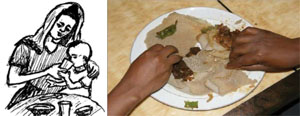Successful transmission of the infectious agent requires it to enter the host through a specific part of the body before it can cause disease. The site through which an infectious agent enters the host is called the route of entry.
We have already mentioned all the routes of entry in previous sections. Can you summarise what they are, and give an example of an infectious agent for each of them?
Show answer
The routes of entry are:
- The respiratory tract: some infectious agents enter the body in air breathed into the lungs. Example: Mycobacterium tuberculosis.
- The gastrointestinal tract: some infectious agents enter through the mouth. Example: the infectious agents causing diarrhoeal diseases enter through the mouth in contaminated food, water or on unclean hands (Figure below).
- The skin provides a natural barrier against entry of many infectious agents, but some can enter through breaks in the skin. Example: malaria parasites (Plasmoduim species) get into the body when an infected mosquito bites through the skin to suck blood.

Some infectious agents get into the body with contaminated food, water or on hands. (Photo: Basiro Davey)
Can you think of an infectious agent that enters and exits through the same body part? Can you think of one where the entry and exit routes are different parts of the body?
Show answer
The route of entry and exit for Mycobacterium tuberculosis is through the respiratory system. The route of entry for infectious agents of diarrhoeal diseases is the mouth, but the route of exit is the anus with the faeces.

